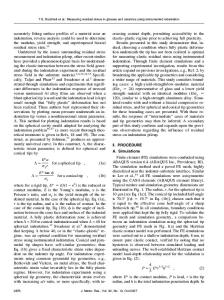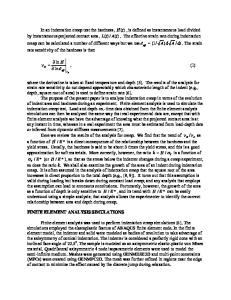An indentation method for evaluation of residual stress: Estimation of stress-free indentation curve using stress-indepe
- PDF / 768,133 Bytes
- 9 Pages / 584.957 x 782.986 pts Page_size
- 50 Downloads / 432 Views
An indentation method for evaluation of residual stress: Estimation of stress-free indentation curve using stress-independent indentation parameters Jong-hyoung Kim1, Sungki Choi1, Junsang Lee1, Hee-Jun Ahn2, Young-Cheon Kim3, Min-Jae Choi4,a) , Dongil Kwon1 1
Department of Materials Science and Engineering, Seoul National University, Seoul 08826, Korea Semiconductor R&D Center, Samsung Electronics, Hwaseong, Gyeonggi-do 18448, Korea School of Advanced Materials Engineering, Andong National University, Andong, Gyeongsangbuk-do 36729, Korea 4 Nuclear Materials Research Division, Korea Atomic Energy Research Institute, Daejeon 34057, Korea a) Address all correspondence to this author. e-mail: [email protected] 2 3
Received: 3 September 2018; accepted: 20 November 2018
Residual stress is generally evaluated using indentation by comparing the indentation curves of stressed and stress-free states. Here, we suggest a new method that can evaluate surface residual stress without indentation testing on stress-free specimen using stress-independent indentation parameters and an analysis of indentation contact morphology for the stress-free state. We found that several indentation parameters are independent of the stress by Vickers indentation testing on various stress states. The indentation contact morphology can be represented by indentation parameters including stress-independent ones, and by applying the stressindependent parameters obtained from the stressed state to the indentation contact depth function, we can estimate an indentation curve for stress-free state. The estimated curve matches well with the experimental stress-free indentation curve, and it was also confirmed that the applied stress values evaluated by comparing the estimated curve with the stressed indentation curve agree well with the reference values obtained from strain gauge.
Introduction Residual stress is the stress present in an object when there is no external force. Because residual stresses can cause unexpected behavior or failure of the object, quantitative residual-stress-evaluating techniques such as hole drilling, sectioning, and XRD have been used to evaluate the residual stress to study integrity of structures. In addition to these conventional methods, however, residual stress measurement using indentation offers the advantages of quantitative results, nondestructive and simple testing. Tsui et al. [1] have shown the effects of stress on indentation measurements of hardness and elastic modulus experimentally, and Bolshakov et al. [2] have shown stress effects using FEA simulation. Both these studies demonstrate that elastic modulus and hardness calculated using the real contact area as measured by optical microscopy do not depend on the stress state of specimen.
ª Materials Research Society 2019
Suresh and Giannakopoulos [3] developed a model for evaluating equibiaxial residual stress and residual plastic strains using instrumented sharp indentation, and this model is demonstrated by Carlsson and Larsson [4, 5]. Lee and Kwon [6] s
Data Loading...











